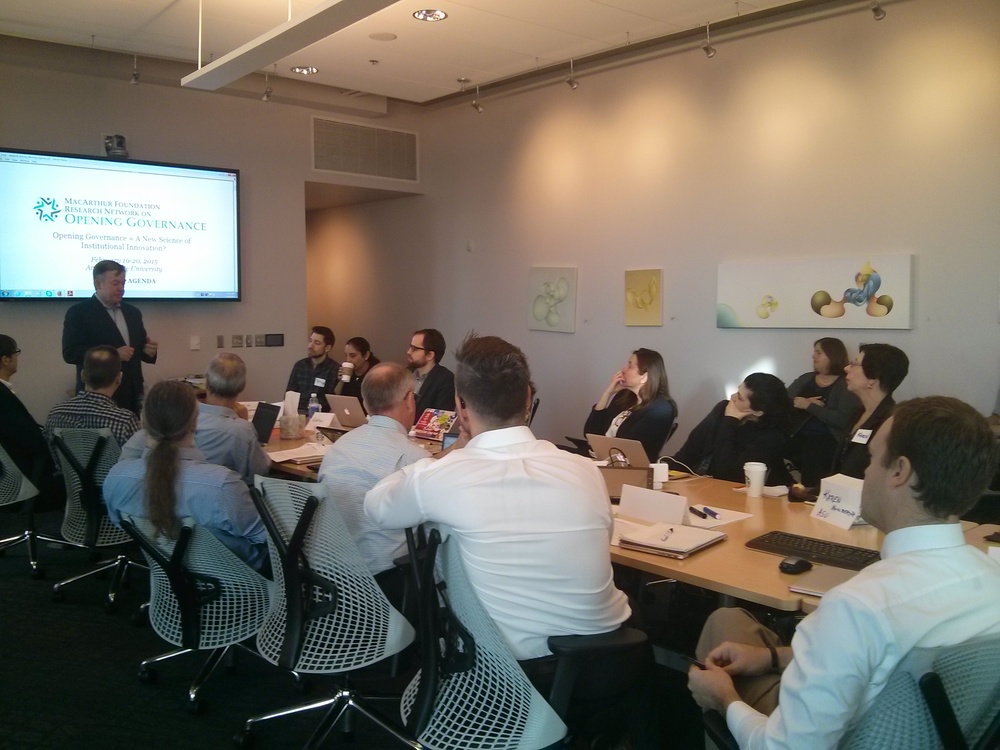
On February 19th and 20th, the MacArthur Foundation Research Network on Opening Governance held its first convening of 2015 on the campus of Arizona State University. Participants in the meeting included Network members, Network post-docs and guests from the Arizona open governance community (see full list below).
The meeting kicked off with a presentation and Q&A with Arizona State University President Michael Crow. President Crow discussed at length the ways in which ASU is reimagining university governance through an approach where: 1) the university’s “prestige” does not come from the number of applicants that it excludes – as is the case with most top universities – but rather on the success of those included; 2) academic success is measured based on how research benefits the public good in a concrete way, not on medals awarded to professors; and 3) the university takes responsibility for the social, economic, cultural and health wellbeing of the community of which it is a part. This discussion of ASU’s success using a more open and inclusive governance structure was an ideal opening for a meeting in which Network members, post-docs and guests worked to collaboratively define key elements of opening governance more broadly – from objectives to necessary training mechanisms to metrics of success. The ASU experiment is in many ways a proof-of-concept regarding the potential for institutions to reimagine the ways in which they make governing decisions.
With a focus on collaboratively developing outputs and President Crow’s framing as inspiration, the assembled participants sought to answer four key questions:
- What are the contours of a new science of opening governance, and how can they be articulated to the public?
- What are the central elements and questions that define a common research agenda on opening governance, for the Network and the field at large?
- How should the next generation of public problem-solvers be trained – both in terms of structure and content?
- How should open governance projects measure success, and is the development of a broadly applicable metrics framework possible?
Given the meeting’s focus on producing concrete outputs, we will follow this post with individual recaps of the discussions and deliverables from the extended collaboration sessions built around each of the meeting’s four central questions.
View the full meeting agenda here.
Meeting Participants:
- Ken Abbott, Center for Law, Science and Innovation
- Marty Anderies, Center for the Study of Institutional Diversity
- Keiron Bailey, University of Arizona School of Geography and Development
- Michael Barton, Global Institute of Sustainability
- Patrick Bergemann, Columbia Business School
- Stefana Broadbent, Nesta
- Travis Certo, Arizona State University W.P. Carey School of Business
- Valerie Chang, MacArthur Foundation
- Deborah Estrin, Cornell Tech
- Lucky Gunasekara, Cornell Tech
- Sandro Hawke, Massachusetts Institute of Technology
- Eric Heckler, Designing Health Lab
- Amy Hillman, Arizona State University W.P Carey School of Business
- Jay Horwitz, University of Toronto
- Sheena Iyengar, Columbia Business School
- Marcco Janssen, Center for the Study of Institutional Diversity
- Erik Johnston, Arizona State University
- Alan Kantrow, The GovLab
- Justin Longo, Arizona State University
- Laurie Mook, Participatory Governance Institute
- Karen Mossberger, Arizona State University School of Public Affairs
- Geoff Mulgan, Nesta
- Michael Schoon, Global Institute of Sustainability
- Beth Simone Noveck, The GovLab
- Lee Rainie, Pew Research Center
- Daniel Shugherensky, Participatory Governance Institute
- Ariel Dora Stern, Harvard Business School
- Stefaan Verhulst, The GovLab
- **Andrew Young, The GovLab

